
Metahaven in collaboration with IMMI, Data / Saga, digital models and sketches, 2013
I was wondering if you could tell me a little bit about the foundations and origin of Metahaven.
Metahaven is a strategic graphic design agency. We make anything between a conference, a publication, an interview, a product, a visual identity, a policy document, or a set of floating appearances on the Internet. We are not only interested in the development of hypothetical image, but also in its realization. Some of our projects are an identity proposal for the Principality of Sealand, which is an off-shore micronation which played an iconic role as a “data haven” during the late 1990s dotcom boom. In 2010 we released Uncorporate Identity—a design book for our dystopian age. Some parts of Uncorporate Identity were about dismantling and attacking the “brand state”—the notion of promoting or creating reputations for countries—and by proxy, about dismantling branding itself. We have also attacked and criticized Joseph Nye’s notion of “soft power”—the power to attract—which is arguably the only political concept which branding has ever heard of. One of our upcoming projects is a collaboration with the Iceland-based think tank IMMI, thinking up a set of images and messages for the excellent and forward-thinking legal, energy, and social environment which Iceland has created for internet and cloud hosting. We recently interviewed two people who are involved in this: Eleanor Saitta and Smári McCarthy. Both of them work for IMMI.

Metahaven in collaboration with IMMI, Data / Saga, digital models and sketches, 2013
You've spoken of current conceptions of branding a processes of consolidation as opposed to differentiation. In a post on your Tumblr related to an exhibition at the Museum of Display in Antwerp, you write that the process of assigning identity is "a surface or screen by which an organization mirrors its surroundings, both in the physical space as well as in information space." In an article you wrote about 4 years ago in e-flux, which was also published in Uncorporate Identity, you suggested that state branding had to become "more concerned with both the structural standardization implied by network power and a pluralistic understanding of decentralized and distributed political alternatives being developed on various scales." How do you feel design and branding can function to create a multiplicitous understanding of identities that operate within political contexts?

Metahaven, Uncorporate Identity, Lars Müller Publishers, 2010
A brand is a socially and economically sustained form of prejudice. Branding is the management of first impressions, and to that end, it is inherently deceitful. To establish the few initial thoughts people have about something is a very hard thing to accomplish by design, but is swiftly and almost irreversibly done by uncontrollable events; reputations literally shift overnight. The main way in which branding has been embodied in politics is through the concept of soft power. As the Innocence of Muslims YouTube video showed, American soft power can be affected, inversed even, overnight, by only a handful of pixels.
Not soft power, but “network power” should be regarded as the structural force behind presence and identity. This idea, which is explored in more detail in Uncorporate Identity, takes globalization as a process unfolding through various standards: of communication, exchange, payment, travel, language, etc. Such standards both enable and limit actors in their agency and choice of alternatives. Importantly, such network standards are ultimately predominant over the positive or negative emotions associated with particular actors in or on the network. In the case of the Innocence of Muslims video, for example, American soft power is volatile, while its network power—YouTube—is stable. In other words, the network power is a prerequisite to even have soft power.
In Brand States we argued that “[s]tate branding ultimately requires a new paradigm that goes beyond soft power—one less focused on promotion and indeed more concerned with both the structural standardization implied by network power and a pluralistic understanding of decentralized and distributed political alternatives being developed on various scales.”
This is indeed what one would expect of an independent and forward-looking state.
In soft power, allegedly no coercion is necessary for a state to achieve desired outcomes. It can achieve these same outcomes by being attractive. State branding thus purports it can make a state look more attractive and legitimate by more carefully organizing the first impression—or prejudice—held about that state by relevant others. It is of particular interest to us how Western branding and PR firms acted as middle men in doing this authoritarian regimes in the Middle East, Libya being the most glaring example.

The Future Of Soft Power Depends On A Handful Of Pixels, from Metahaven, Disposable Imagecraft, 2012
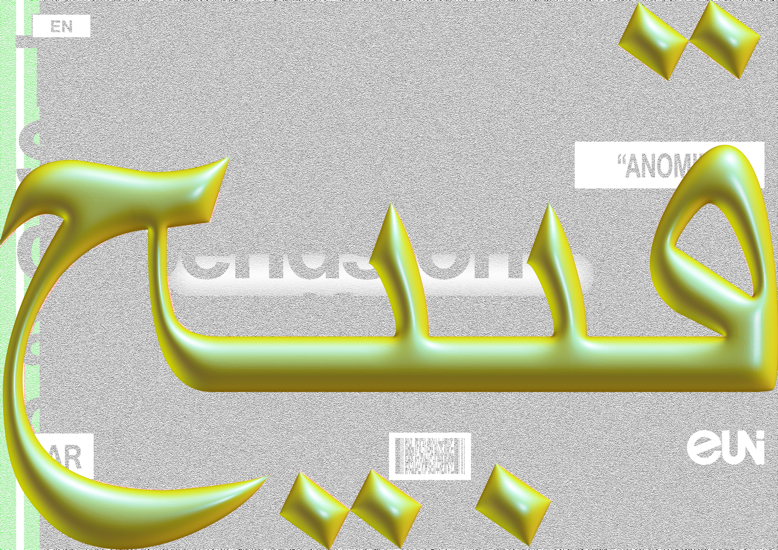
Anomie, from Metahaven, Disposable Imagecraft, 2012
How did that practice in Libya play out?
Via Qaddafi’s glamorous playboy heir Saif, the regime “included” its own self-criticism. Monitor, a Boston-based lobbying firm, was hired by Qaddafi to boost the country’s image. Monitor then “provided advice” (er, co-wrote) Saif Qaddafi's PhD thesis at the London School of Economics (LSE) and brokered relations for him with influential thinkers in the West. All this happened in a covert way. Saif thanks Joseph Nye, the Harvard professor who coined the concept of soft power, for helping him out with his thesis writing, which is coincidentally largely about soft power. In 2007, Nye visited Libya, on the invitation of and paid for by Monitor. For The National Review, Nye reported about his trip, and shed a somewhat favorable light on Saif’s father, mentioning that “[…] Qaddafi has long been seen as a bad boy in the West. Yet, in recent years, Qaddafi has appeared to be changing. He still wants to project Libyan power, but he is going about it differently than in decades past. Where once he had tried to bully and even overthrow governments to his south, now he is hosting peace talks on Darfur. Where once he sought weapons of mass destruction, now he has abandoned his nuclear program. These moves have paid off: A decade ago Libya was subject to U.N. Security Council sanctions; recently, the United States raised no objection to Libya being seated on the Security Council. Qaddafi, in other words, seems to have become interested in soft power—the art of projecting influence through attraction rather than coercion.”
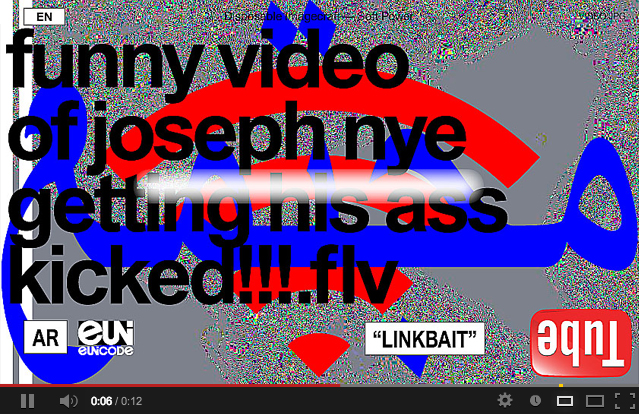
Funny video of Joseph Nye getting his ass kicked!!!.flv, screen shots from YouTube video, From Metahaven, Disposable Imagecraft, 2012
So, what happens is this: the inventor of soft power gets paid to write that Qaddafi is now doing soft power. Mother Jones found that Nye indeed visited Libya as a paid consultant for Monitor. Nye admitted to this in an e-mail to the magazine. Four years later, when it had become apparent to him that “Qaddafi's departure is the only change that will work in Libya,” Nye posthumously belittled his own role in Saif’s PhD: “... at the request of a friend, I read one chapter that referred to soft power, something I have done for many who have written about that topic. Otherwise, I was not involved in his thesis and know nothing about the controversy about it that the London School of Economics is now investigating.”
Saif mentions “a number of experts with whom I met and who consented to read portions of the manuscript and provide advice and direction, especially Professor Joseph Nye.” Nye says he was only in contact with Saif through “a friend.” Saif maintains he met with Nye in person, who provided him with advice and direction. Saif deals with soft power in two chapters, which together span over one third of the thesis.
Saif’s thesis claimed that “[t]he improved human rights record in Libya is in part due to the campaign by the Qaddafi Foundation and other international human rights NGOs.”[1] The snake bites its own tail again: the Qaddafi Foundation was Saif’s own charity organization and boutique outfit for the Libyan regime, which also became a London School of Economics funding agent. Now defunct, it was an instrument to wield soft power for the dictator’s family. Not just the charity’s activities but also Saif’s thesis paper should be taken for what they are: a concerted nation branding campaign underpinned by the hard power of cash money. Soft power here is not founded on attraction, but on economic and military interests, re-packaged like credit default swaps.
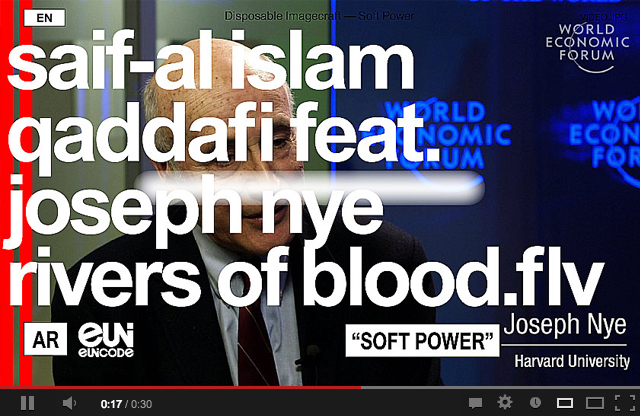
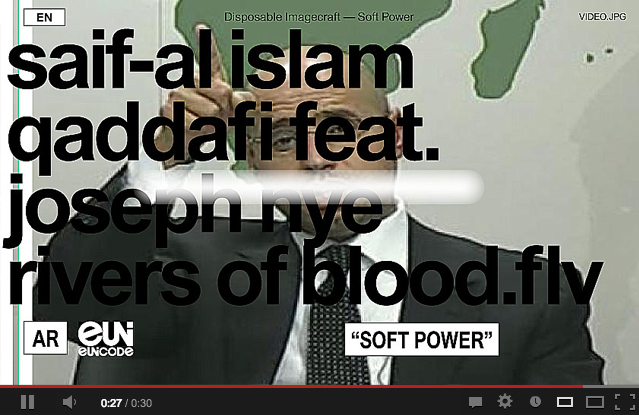
Saif Al Islam Qaddafi feat. Joseph Nye—Rivers of Blood.flv, screen shots from YouTube video, from Metahaven, Disposable Imagecraft, 2012
In that same piece on Tumblr, you mention that "Space taken up by pseudo-originary forms and shapes supposedly rendering an organization visible amidst a firestorm of signs and signals, would be much better used if organizations dared not to be original." This reminded me of something I read in Buñuel's autobiography, where he says everything original is a cliche by default. I'm wondering if you can talk about this concept of un-originality. What are its origins for you? Do you see it functioning in other facets of creative production?
By saying just that we simply meant that a lot of what organizations are about is embedded in their context. They are not these unique, sovereign forms, at least not anymore. In a sense every work based on the Internet, or inspired by it, is opposed against the idea of originality. Everything in and of the Internet is a stimulus package for the endlessly derivative, in the same way that a mirror image is a derivative of an original. Not a copy, but a mirror.
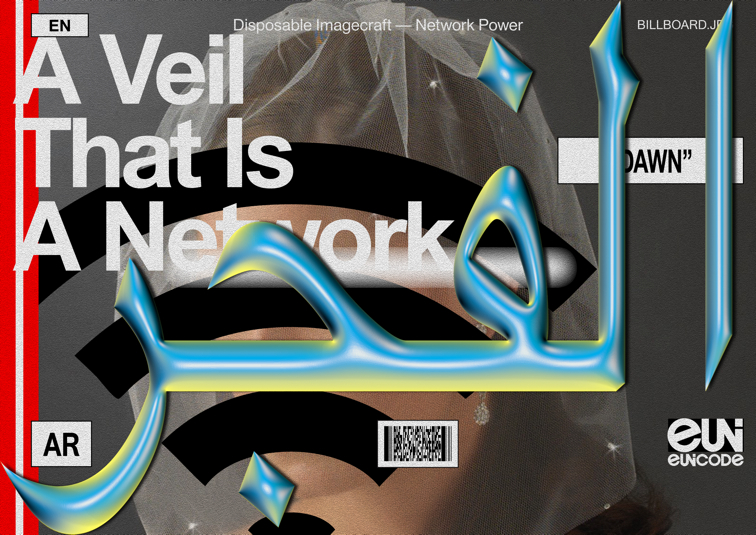
A Veil That Is A Network, from Metahaven, Disposable Imagecraft, 2012
How does your understanding of that ability relate to your conception of memes and jokes that are "supercharged by social media," as outlined by Daniel in his talk at Typo Berlin?
It is basically a story about jokes as political and design objects, which we're currently making into an e-book for Strelka Press—the publishing branch of the Moscow-based architecture and design space. A meme is not always a joke, but a very good joke is almost always a meme. A joke is a form of resistance. We are looking at jokes as cascades; can jokes trigger the takedown of a political order by cascading its ridiculousness? The idea of the joke and the meme is also related to the dissolution of the older idea of “graphic design” as an activity on a meaningful political and social scale; it is the dissolution of the societal middle ground institutions and the welfare state which has triggered the demise of graphic design in that role. It is with the internet as an amplifier that this perspective can be suddenly liberating. The way memes form and spread on the internet gives us living, ever-changing proof of how a global medium can develop its specific sense of “humor” (medium-specific, we mean). Ethan Zuckerman's cute cat theory of political activism is one source for our thesis; other sources (eclectically chosen) are Desiderius Erasmus, Monty Python, George Clinton, Beppe Grillo, and such.
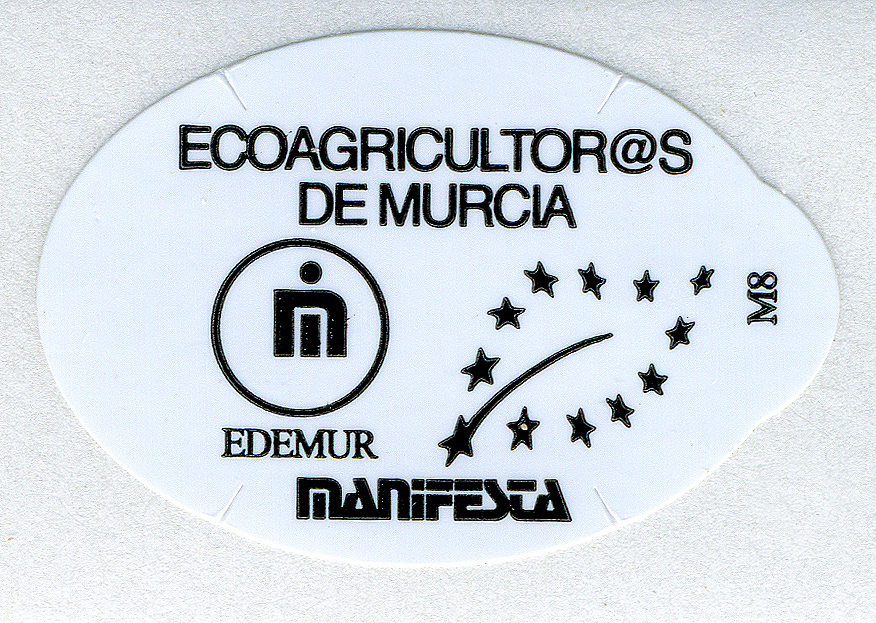
Metahaven, Signal (Murcia), fruit stickers for Ecoagricultoras de Murcia, courtesy Manifesta8, Murcia/Cartagena, 2010
Your current project, 0. Democracy Without Secrets, utilizes structures of social media networks to incite users to interact more readily with government. Transparency is a contemporary catchword you've spoken of before. How does your project relate to contemporary forms of transparency supposedly enacted by governments, corporations, and other organizations?
Democracy Without Secrets is the logical end conclusion of the failing legitimacy of our democratic governments: that they are not at all democratic. We need to return to an idea of democracy that is more fundamental and real. The idea—which interacts with a new Freedom of Information Act currently in the works in the Netherlands—is that instead of request-based FOIA, there is a database with government documents and a list of all documents that exist. This we call the “leaking State.” Nulpunt or 0., a project together with the artist Jonas Staal, is projected as a mix between WikiLeaks and Twitter, in that it organizes users socially around the information in that database (note: Iceland, Estonia and Norway already have automatically disclosed databases); they can “subscribe” to document streams a bit like an RSS feed and they can lift chunks of text out of these documents to discuss or simply just highlight, and “broadcast” these via social media. FOIA is not just for investigative journalists but for everyone. Nulpunt/0.—initiated and developed by Metahaven together with the artist Jonas Staal—is not just a transparency website but a fundamental piece of political reform. It is founded on the idea that legitimate democracy is a democracy without secrets, incorporating WikiLeaks-like mechanisms, techniques and paradigms into governance.
The images that go along with your ongoing "Captives of the Cloud" series on e-flux are quite striking. While they work in tandem with the text, it would be reductive to call them illustrations. How do you conceive of the relationship between your texts and images? How do certain concepts and histories -- like "The Mubarak 'kill switch' which took Egypt off the internet in January, 2011" -- become visualized and designed?
We are not necessarily big fans of data visualization. On the other hand when something is written that is supposed to be informative, there could be a need for a visual counterpart to that writing that helps the information come across. We’ve had different responses to the Captives of the Cloud pictures—one Icelandic programmer recently asked “if we used MS Paint to make them.” (We didn’t.)
With those Captives images it was fun to come up with titles for them, like “Extrajudicial Dislike, “Embargo-on-Demand,” or “Twittertrace.” They are a bit like cartoons or comics more than just visualizations. It’s always a lot of work getting the information together and as soon as one graphic is finished it feels outdated within a day or two... so it is really frustrating at the same time. Data visualization gives people sometimes a strong feeling of understanding about an issue; like “let’s map the financial crisis up to the millisecond.” What you get is that this visualization becomes its own entertainment; rather than uniting against the bankers, we look at graphs about them... rather than putting financial fraudsters in jail we are entertained by interactive maps that show who they’re connected to... The use of intentionally primitive, cartoon-like visuals is a bit of a response to this “all-encompassing” cockpit infographic.

Metahaven, Guantánamo Bay Manual t-shirt, 2011
Finally, can you tell me about the scarves and t-shirts you designed for WikiLeaks last year?
An artistic collaboration in 2010 and 2011 with the controversial but essential whistleblowing website WikiLeaks began as a redesign of their “visual identity,” but became a project where we made scarves and t-shirts as products which WikiLeaks could sell. Most recently, these scarves and t-shirts are being displayed (and sold) at Artists Space in New York as part of the group show Frozen Lakes. We designed these products for WikiLeaks as a way to support them, and WikiLeaks sold these items through an online auction and subsequent sales events. A blockade by major financial institutions prevents the site from receiving public donations. We've designed a range of scarves, which, as semi-transparent cloaks, were meant to speak to a combination of secrecy and transparency; their lettering and patterning speak to scarves as black market items sold in a global zone of anarchy and free trade. Then there's a range of t-shirts with each shirt simply printing “WikiLeaks” (in a wavy Times New Roman) and the date and title of an important leak.
Metahaven is an Amsterdam-based design collective on the cutting blade between politics and aesthetics. Founded by Vinca Kruk and Daniel van der Velden, Metahaven's work—both commissioned and self-directed—reflects political and social issues through research-driven design, and design-driven research. Research projects included the Sealand Identity Project, and currently include Iceland as Method. Clients include Droog Design, Tensta konsthall, Bloomberg Businessweek, Luma Foundation, Sternberg Press, Van Abbemuseum, and Valiz. Solo exhibitions include Affiche Frontière (CAPC musée d'art contemporain de Bordeaux, 2008) and Stadtstaat (Künstlerhaus Stuttgart/Casco, 2009), and Islands in th Cloud (MoMA PS1, 2013). Group exhibitions include Forms of Inquiry (AA London, 2007, cat.), Manifesta8 (Murcia, 2010, cat.), the Gwangju Design Biennale 2011 (Gwangju, Korea, cat.), Graphic Design: Now In Production (Walker Art Center, Minneapolis, 2011, and Cooper-Hewitt National Design Museum, New York, 2012, cat.), The New Public (Museion, Bolzano, 2012, cat.), and Frozen Lakes (Artists Space, New York, 2013). Metahaven's work was published and discussed in The International Herald Tribune, The New York Times, Huffington Post, Courrier International, Icon, Domus, Dazed, The Verge, l'Architecture d'Aujourd'hui, and Mute, among other publications. Vinca Kruk is a Tutor of Editorial Design and Design Critique at ArtEZ Academy of Arts in Arhem. Daniel van der Velden is a Senior Critic at the Graphic Design MFA program at Yale University, and a Tutor of Design at the Sandberg Instituut Amsterdam. In 2010, Metahaven released Uncorporate Identity, a design anthology for our dystopian age, published by Lars Müller.
[1] Qaddafi, 385.

